warning light TOYOTA PROACE 2020 (in English) User Guide
[x] Cancel search | Manufacturer: TOYOTA, Model Year: 2020, Model line: PROACE, Model: TOYOTA PROACE 2020Pages: 430, PDF Size: 48.01 MB
Page 158 of 430
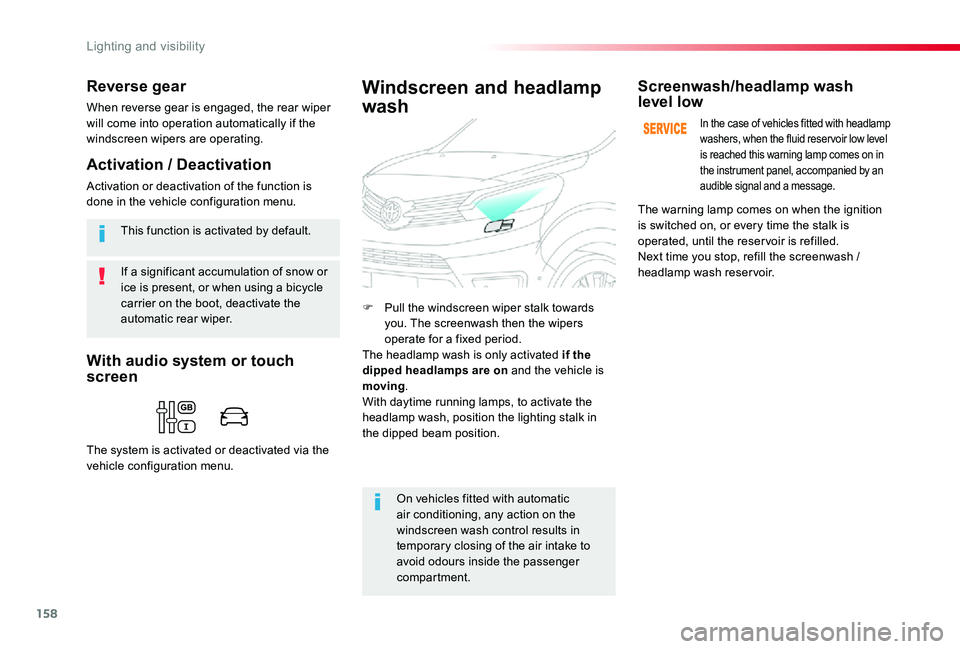
158
If a significant accumulation of snow or ice is present, or when using a bicycle carrier on the boot, deactivate the automatic rear wiper.
This function is activated by default.
Reverse gear
When reverse gear is engaged, the rear wiper will come into operation automatically if the windscreen wipers are operating.
Activation / Deactivation
Activation or deactivation of the function is done in the vehicle configuration menu.
F Pull the windscreen wiper stalk towards you. The screenwash then the wipers operate for a fixed period.The headlamp wash is only activated if the dipped headlamps are on and the vehicle is moving.With daytime running lamps, to activate the headlamp wash, position the lighting stalk in the dipped beam position.
Windscreen and headlamp
wash
On vehicles fitted with automatic air conditioning, any action on the windscreen wash control results in temporary closing of the air intake to avoid odours inside the passenger compartment.
Screenwash/headlamp wash level low
In the case of vehicles fitted with headlamp washers, when the fluid reservoir low level is reached this warning lamp comes on in the instrument panel, accompanied by an audible signal and a message.
The warning lamp comes on when the ignition is switched on, or every time the stalk is operated, until the reser voir is refilled.Next time you stop, refill the screenwash / headlamp wash reservoir.
With audio system or touch screen
The system is activated or deactivated via the vehicle configuration menu.
Lighting and visibility
Page 162 of 430
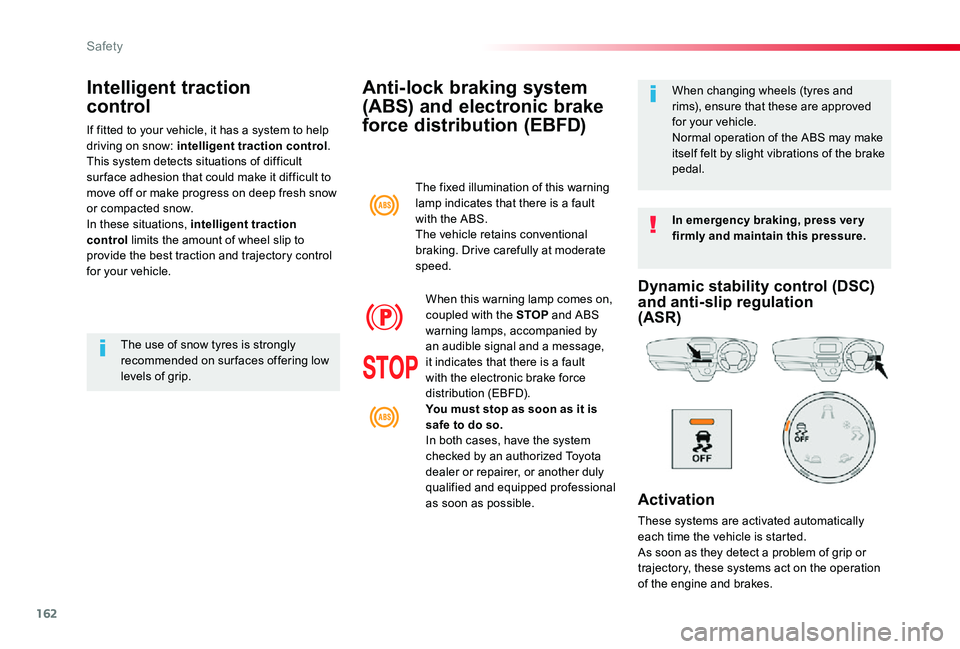
162
Anti-lock braking system
(ABS) and electronic brake
force distribution (EBFD)
In emergency braking, press ver y firmly and maintain this pressure.
When changing wheels (tyres and rims), ensure that these are approved for your vehicle.Normal operation of the ABS may make itself felt by slight vibrations of the brake pedal.
The fixed illumination of this warning lamp indicates that there is a fault with the ABS.The vehicle retains conventional
braking. Drive carefully at moderate speed.
When this warning lamp comes on, coupled with the STOP and ABS warning lamps, accompanied by an audible signal and a message, it indicates that there is a fault with the electronic brake force distribution (EBFD).You must stop as soon as it is safe to do so.In both cases, have the system
checked by an authorized Toyota dealer or repairer, or another duly qualified and equipped professional as soon as possible.
Intelligent traction
control
If fitted to your vehicle, it has a system to help driving on snow: intelligent traction control.This system detects situations of difficult sur face adhesion that could make it difficult to move off or make progress on deep fresh snow or compacted snow.In these situations, intelligent traction control limits the amount of wheel slip to provide the best traction and trajectory control for your vehicle.
The use of snow tyres is strongly recommended on sur faces offering low levels of grip.
Dynamic stability control (DSC) and anti-slip regulation (ASR)
Activation
These systems are activated automatically each time the vehicle is started.
As soon as they detect a problem of grip or trajectory, these systems act on the operation of the engine and brakes.
Safety
Page 169 of 430
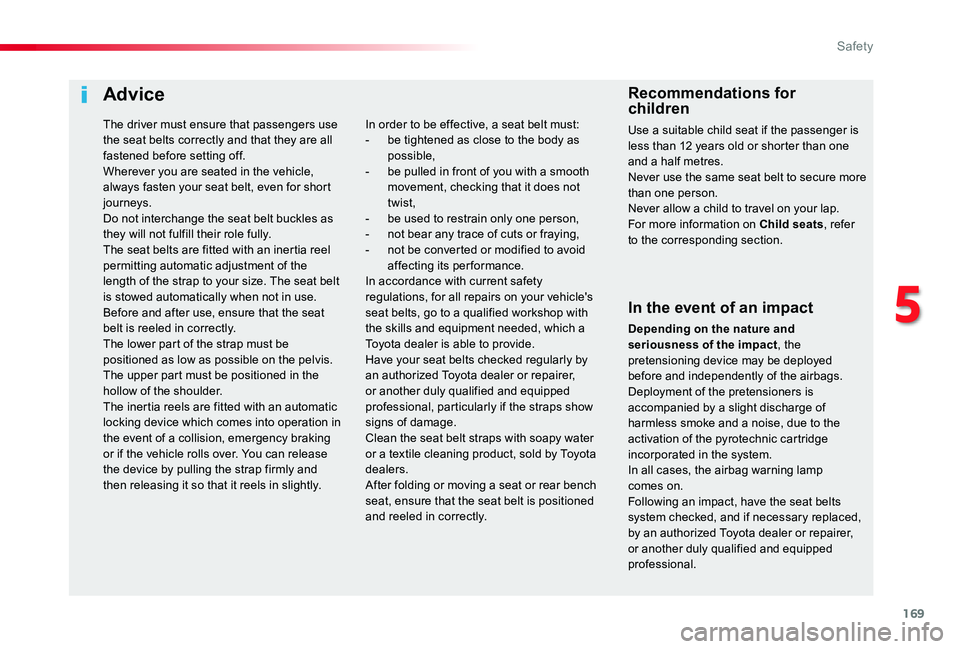
169
Advice
In the event of an impact
Depending on the nature and seriousness of the impact, the pretensioning device may be deployed before and independently of the airbags. Deployment of the pretensioners is accompanied by a slight discharge of harmless smoke and a noise, due to the activation of the pyrotechnic cartridge incorporated in the system.In all cases, the airbag warning lamp comes on.Following an impact, have the seat belts system checked, and if necessary replaced, by an authorized Toyota dealer or repairer, or another duly qualified and equipped professional.
In order to be effective, a seat belt must:- be tightened as close to the body as possible,- be pulled in front of you with a smooth movement, checking that it does not twist,- be used to restrain only one person,- not bear any trace of cuts or fraying,- not be converted or modified to avoid affecting its performance.In accordance with current safety regulations, for all repairs on your vehicle's seat belts, go to a qualified workshop with the skills and equipment needed, which a Toyota dealer is able to provide.Have your seat belts checked regularly by an authorized Toyota dealer or repairer, or another duly qualified and equipped professional, particularly if the straps show signs of damage.Clean the seat belt straps with soapy water or a textile cleaning product, sold by Toyota dealers.After folding or moving a seat or rear bench seat, ensure that the seat belt is positioned and reeled in correctly.
Recommendations for children
Use a suitable child seat if the passenger is less than 12 years old or shorter than one and a half metres.Never use the same seat belt to secure more than one person.Never allow a child to travel on your lap.For more information on Child seats, refer to the corresponding section.
The driver must ensure that passengers use the seat belts correctly and that they are all fastened before setting off.Wherever you are seated in the vehicle, always fasten your seat belt, even for short journeys.Do not interchange the seat belt buckles as they will not fulfill their role fully.The seat belts are fitted with an inertia reel permitting automatic adjustment of the length of the strap to your size. The seat belt is stowed automatically when not in use.Before and after use, ensure that the seat belt is reeled in correctly.The lower part of the strap must be positioned as low as possible on the pelvis.The upper part must be positioned in the hollow of the shoulder.The inertia reels are fitted with an automatic locking device which comes into operation in the event of a collision, emergency braking or if the vehicle rolls over. You can release the device by pulling the strap firmly and then releasing it so that it reels in slightly.
5
Safety
Page 198 of 430

198
When towing
Distribution of loads
F Distribute the load in the trailer so that the heaviest items are as close as possible to the axle and the nose weight approaches the maximum permitted without exceeding it.Air density decreases with altitude, thus reducing engine performance. Above 1 000 metres, the maximum towed load must be reduced by 10 % for every 1 000 metres of altitude.
Side wind
F Take into account the increased sensitivity to side wind.
Cooling
Towing a trailer on a slope increases the temperature of the coolant.As the fan is electrically controlled, its cooling capacity is not dependent on the engine speed.F To lower the engine speed, reduce your speed.The maximum towed load on a long incline depends on the gradient and the ambient temperature.In all cases, keep a check on the coolant temperature.
F If the warning lamp and the STOP warning lamp come on, stop the vehicle and switch off the engine as soon as possible.
Braking
Towing a trailer increases the braking distance.To avoid overheating of the brakes, the use of engine braking is recommended.
Ty r e s
F Check the tyre pressures of the towing vehicle and of the trailer, observing the recommended pressures.
Lighting
F Check the electrical lighting and signalling on the trailer and the headlamp beam height of your vehicle.
For more information on Weights, refer to the corresponding section.
The rear parking sensors will be deactivated automatically to avoid the audible signal if a genuine Toyota towbar is used.
If the ambient temperature is high, it is recommended that the engine be allowed to idle for 1 to 2 minutes after the vehicle comes to a stop, to facilitate its cooling.
For more information on Adjusting the headlamp beam height, refer to the corresponding section.
Driving
Page 246 of 430
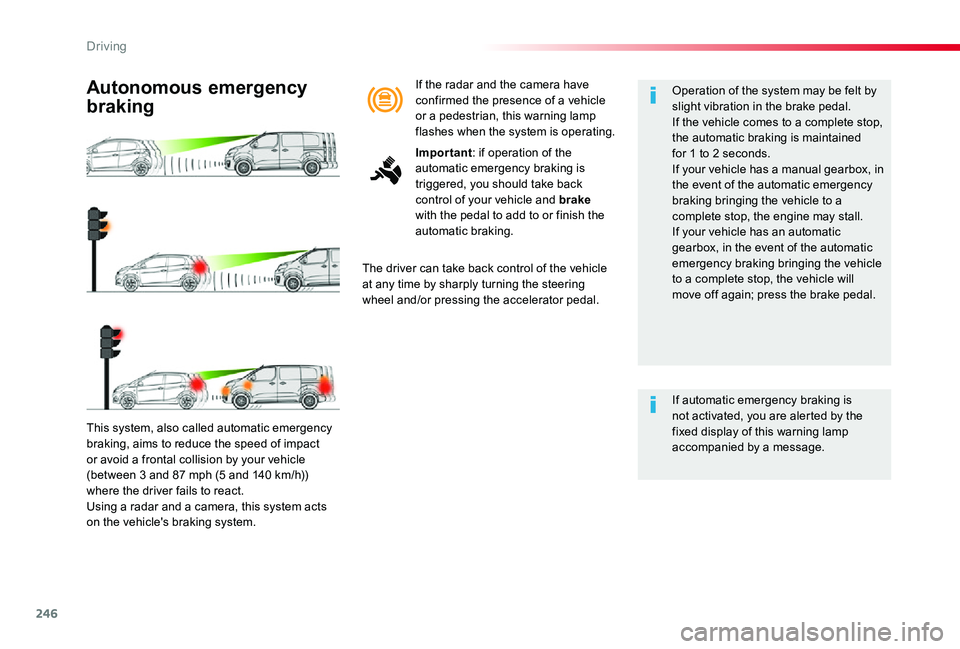
246
This system, also called automatic emergency braking, aims to reduce the speed of impact or avoid a frontal collision by your vehicle (between 3 and 87 mph (5 and 140 km/h)) where the driver fails to react.Using a radar and a camera, this system acts on the vehicle's braking system.
Autonomous emergency
braking
The driver can take back control of the vehicle at any time by sharply turning the steering wheel and/or pressing the accelerator pedal.
Operation of the system may be felt by slight vibration in the brake pedal.If the vehicle comes to a complete stop, the automatic braking is maintained for 1 to 2 seconds.If your vehicle has a manual gearbox, in the event of the automatic emergency braking bringing the vehicle to a complete stop, the engine may stall.If your vehicle has an automatic gearbox, in the event of the automatic emergency braking bringing the vehicle to a complete stop, the vehicle will move off again; press the brake pedal.
If automatic emergency braking is not activated, you are alerted by the fixed display of this warning lamp accompanied by a message.
If the radar and the camera have confirmed the presence of a vehicle or a pedestrian, this warning lamp flashes when the system is operating.
Important: if operation of the automatic emergency braking is triggered, you should take back control of your vehicle and brake with the pedal to add to or finish the automatic braking.
Driving
Page 247 of 430
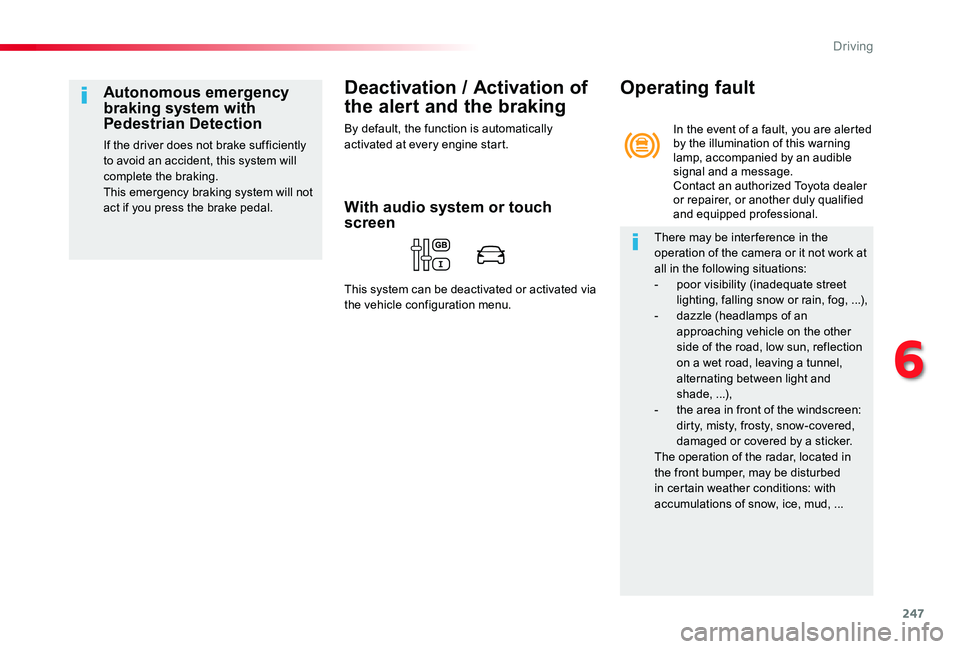
247
Deactivation / Activation of
the alert and the braking
By default, the function is automatically activated at every engine start.
Autonomous emergency braking system with Pedestrian Detection
If the driver does not brake sufficiently to avoid an accident, this system will complete the braking.This emergency braking system will not act if you press the brake pedal.
In the event of a fault, you are alerted by the illumination of this warning lamp, accompanied by an audible signal and a message.Contact an authorized Toyota dealer or repairer, or another duly qualified and equipped professional.
Operating fault
There may be interference in the operation of the camera or it not work at all in the following situations:- poor visibility (inadequate street lighting, falling snow or rain, fog, ...),- dazzle (headlamps of an approaching vehicle on the other side of the road, low sun, reflection on a wet road, leaving a tunnel, alternating between light and shade, ...),- the area in front of the windscreen: dirty, misty, frosty, snow-covered, damaged or covered by a sticker.The operation of the radar, located in the front bumper, may be disturbed in certain weather conditions: with accumulations of snow, ice, mud, ...
With audio system or touch screen
This system can be deactivated or activated via the vehicle configuration menu.
6
Driving
Page 251 of 430

251
Using a camera placed at the top of the windscreen, the system assesses the driver's level of vigilance by identifying variations in trajectory compared to the lane markings.This system is particularly suited to fast roads (speed higher than 40 mph (65 km/h)).
Driver Attention Alert
Depending on version, the "Driving time warning system" may be combined with the "Driver Attention Alert".
The system cannot, in any circumstances, replace the need for vigilance on the part of the driver.Do not drive if you are tired or taking medicines that can cause drowsiness.
Once the system considers that the behaviour of the vehicle suggests a certain level of fatigue or inattention by the driver, it triggers the first level of alert.
After three first level alerts, the system triggers a new alert with the message "Take a break!", accompanied by a more pronounced audible
signal.
In certain driving conditions (poor road sur face or strong winds), the system may give alerts independent of the driver's level of vigilance.
The following situations may interfere with operation of the system or prevent it working:- poor visibility (inadequate lighting of the roadway, falling snow, heavy rain, dense fog, ...),- dazzle (headlamps of an oncoming vehicle, low sun, reflections on a damp road, leaving a tunnel, alternating shade and light, ...),- windscreen area located in front of the camera: dirty, misted, frost-covered, snow-covered, damaged or covered by a sticker,- lane markings absent, worn, masked (snow, mud) or multiple
(roadworks, ...),- close to the vehicle ahead (lane markings not detected),- roads that are narrow, winding, ...
The driver is then alerted by the message "Ta k e c a r e !", accompanied by an audible signal.
6
Driving
Page 252 of 430

252
Blind spot monitoring system
A warning lamp appears in the door mirror on the side in question:- immediately, when being overtaken,- after a delay of about one second, when overtaking a vehicle slowly.
This driving assistance system warns the driver of the presence of another vehicle in the blind spot angle of their vehicle (areas masked from the driver's field of vision), as soon as this presents a potential danger.
The alert is given by a warning lamp which comes on in the door mirror on the side in question as soon as a vehicle - car, lorry, bicycle - is detected and the following conditions are fulfilled:- all the vehicles must be moving in the same direction and on adjacent lanes,- the speed of your vehicle is between 7 and 87 mph (12 and 140 km/h),- when you overtake a vehicle with a speed difference of less than 6 mph (10 km/h),- when a vehicle overtakes you with a speed difference of less than 15 mph (25 km/h),- the traffic must be flowing normally,- in the case of an overtaking manoeuvre, if this is prolonged and the vehicle being overtaken returns to the blind spot,- you are driving on a straight or slightly curved road,- your vehicle is not pulling a trailer, a caravan...
This system is designed to improve safety when driving and is in no circumstances a substitute for the use of the interior rear view mirror and door mirrors. It is the driver's responsibility to constantly check the traffic, to assess the distances and relative speeds of other vehicles and to predict their movements before deciding whether to change lane.The blind spot sensor system does not replace the need for vigilance on the part of the driver.
Driving
Page 271 of 430
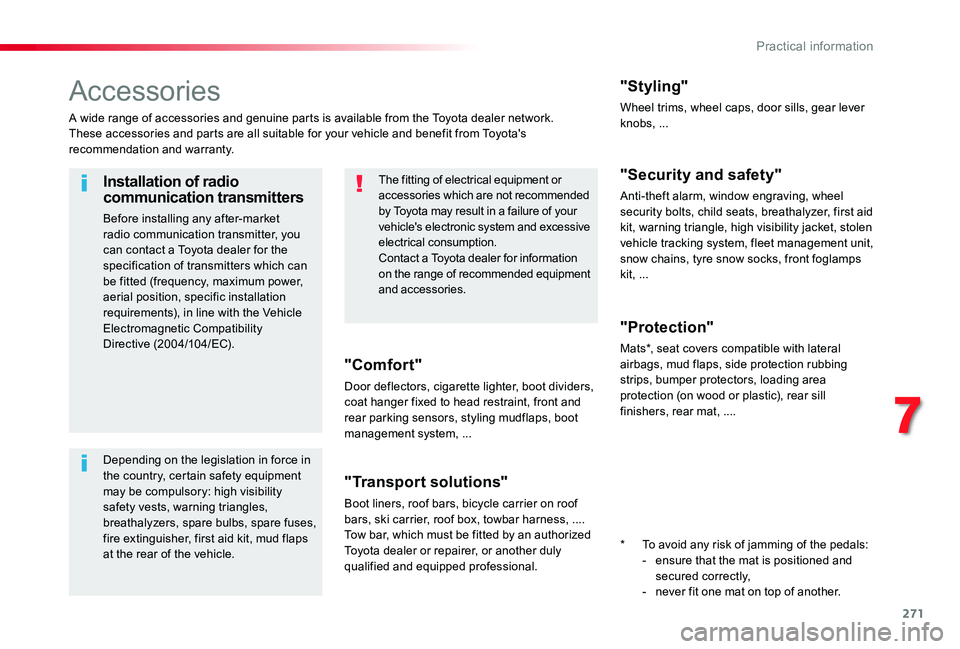
271
Accessories
A wide range of accessories and genuine parts is available from the Toyota dealer network.These accessories and parts are all suitable for your vehicle and benefit from Toyota's recommendation and warranty.
"Comfort"
Door deflectors, cigarette lighter, boot dividers, coat hanger fixed to head restraint, front and rear parking sensors, styling mudflaps, boot management system, ...
"Transport solutions"
Boot liners, roof bars, bicycle carrier on roof bars, ski carrier, roof box, towbar harness, ....Tow bar, which must be fitted by an authorized Toyota dealer or repairer, or another duly qualified and equipped professional.
"Styling"
Wheel trims, wheel caps, door sills, gear lever knobs, ...
"Security and safety"
Anti-theft alarm, window engraving, wheel security bolts, child seats, breathalyzer, first aid kit, warning triangle, high visibility jacket, stolen vehicle tracking system, fleet management unit,
snow chains, tyre snow socks, front foglamps kit, ...
"Protection"
Mats*, seat covers compatible with lateral airbags, mud flaps, side protection rubbing strips, bumper protectors, loading area protection (on wood or plastic), rear sill finishers, rear mat, ....
The fitting of electrical equipment or accessories which are not recommended by Toyota may result in a failure of your vehicle's electronic system and excessive electrical consumption.
Contact a Toyota dealer for information on the range of recommended equipment and accessories.
Installation of radio communication transmitters
Before installing any after-market radio communication transmitter, you
can contact a Toyota dealer for the specification of transmitters which can be fitted (frequency, maximum power, aerial position, specific installation requirements), in line with the Vehicle Electromagnetic Compatibility Directive (2004/104/EC).
Depending on the legislation in force in the country, certain safety equipment may be compulsory: high visibility safety vests, warning triangles, breathalyzers, spare bulbs, spare fuses, fire extinguisher, first aid kit, mud flaps
at the rear of the vehicle.* To avoid any risk of jamming of the pedals:- ensure that the mat is positioned and secured correctly,- never fit one mat on top of another.
7
Practical information
Page 421 of 430
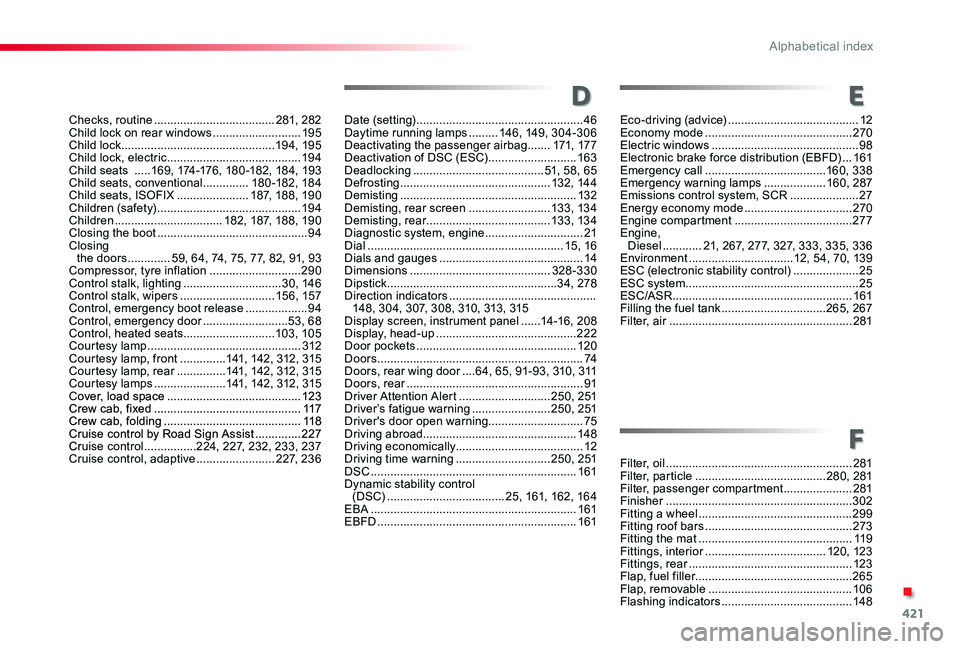
421
Checks, routine .....................................281, 282Child lock on rear windows ...........................195Child lock ...............................................19 4, 195Child lock, electric .........................................19 4Child seats .....169, 174-176, 180 -182, 184, 193Child seats, conventional ..............18 0 -182, 18 4Child seats, ISOFIX ......................187, 188, 190Children (safety) ............................................19 4Children .................................182, 187, 188, 190Closing the boot ..............................................94Closing the doors .............59, 64, 74, 75, 77, 82, 91, 93Compressor, tyre inflation ............................290Control stalk, lighting ..............................3 0, 14 6Control stalk, wipers .............................15 6, 157Control, emergency boot release ...................94Control, emergency door ..........................53, 68Control, heated seats ............................103, 105Courtesy lamp ...............................................312Courtesy lamp, front ..............141, 142, 312, 315Courtesy lamp, rear ...............141, 142, 312, 315Courtesy lamps ......................141, 142, 312, 315Cover, load space .........................................123Crew cab, fixed .............................................117Crew cab, folding ..........................................11 8Cruise control by Road Sign Assist ..............227Cruise control ................224, 227, 232, 233, 237Cruise control, adaptive ........................2 2 7, 2 3 6Filter, oil .........................................................281Filter, particle ........................................280, 281Filter, passenger compartment .....................281Finisher .........................................................302Fitting a wheel ...............................................299Fitting roof bars .............................................273Fitting the mat ...............................................11 9Fittings, interior .....................................120, 123Fittings, rear ..................................................123Flap, fuel filler ................................................265Flap, removable ............................................10 6Flashing indicators ........................................148
D
F
E
Date (setting) ...................................................46Daytime running lamps .........14 6, 149, 3 0 4 - 3 0 6Deactivating the passenger airbag .......171, 17 7Deactivation of DSC (ESC) ...........................163Deadlocking ........................................51, 58, 65Defrosting ..............................................132, 14 4Demisting ......................................................132Demisting, rear screen .........................13 3, 13 4Demisting, rear ......................................13 3, 13 4Diagnostic system, engine ..............................21Dial ............................................................15, 16Dials and gauges ............................................14Dimensions ...........................................328-330Dipstick ....................................................34, 278Direction indicators .............................................148, 304, 307, 308, 310, 313, 315Display screen, instrument panel ......14 -16 , 2 0 8Display, head-up ...........................................222Door pockets .................................................120Doors ...............................................................74Doors, rear wing door ....64, 65, 91-93, 310, 311Doors, rear ......................................................91Driver Attention Alert ............................250, 251Driver’s fatigue warning ........................250, 251Driver's door open warning .............................75Driving abroad...............................................148Driving economically.......................................12Driving time warning .............................250, 251DSC ...............................................................161Dynamic stability control (DSC) ....................................25, 161, 162, 16 4EBA ...............................................................161EBFD .............................................................161
Eco-driving (advice) ........................................12Economy mode .............................................270Electric windows .............................................98Electronic brake force distribution (EBFD) ...161Emergency call .....................................160, 338Emergency warning lamps ...................160, 287Emissions control system, SCR .....................27Energy economy mode .................................270Engine compartment ....................................277Engine, Diesel ............21, 267, 277, 327, 333, 335, 336Environment ................................12, 54, 70, 139ESC (electronic stability control) ....................25ESC system .....................................................25ESC/ASR .......................................................161Filling the fuel tank ................................265, 267Filter, air ........................................................281
.
Alphabetical index